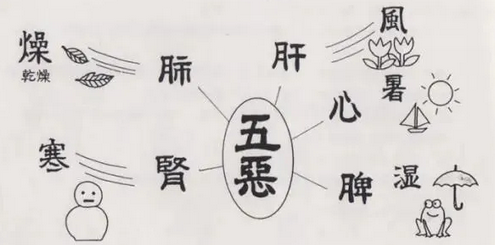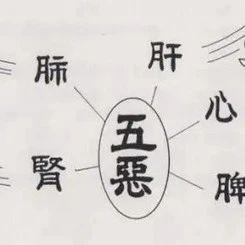Inheriting the legacy of Qi Huang, a public account with substance and warmth.
Ai Yu Xiang Tang
The occurrence and development of diseases fundamentally stem from contradictions within the human body. Traditional Chinese Medicine (TCM) uses the concept of Yin and Yang to represent these contradictions; only through abnormal changes in Yin and Yang can diseases arise.

Generally, what is referred to as the cause of disease or pathogenic factors essentially falls under the category of external causes, which are conditions for the occurrence of diseases. TCM categorizes common pathogenic factors into six excesses (liuxin), pestilential qi, diet, irregularities, phlegm, emotional disturbances, external injuries, insect and animal bites, overexertion, and sexual activity. Different pathogenic factors can lead to different changes through contradictions within the body. Therefore, one can deduce the cause of a disease based on its manifestations (examining symptoms to seek causes), which is an important aspect of TCM diagnosis and treatment. The six excesses are: Wind, Cold, Heat, Dampness, Dryness, and Fire, which are the six qi of nature. Abnormal changes in these six qi, such as excess or deficiency, or abnormal climate, can become pathogenic factors when the body’s resistance is low, hence they are also called six excesses.
1. Wind. Wind is the predominant qi of spring, but it can occur in all seasons and often combines with other pathogenic factors, making wind-related diseases quite common. Characteristics of wind diseases include: (1) rapid onset and quick resolution; (2) symptoms often present as wandering and variable; (3) wind can cause skin irritation and itching; (4) symptoms of aversion to wind. Common wind diseases include:
1. Common cold: aversion to wind, sweating, headache, nasal congestion, or fever, with a thin white coating and a floating, slow pulse. Treatment should disperse wind pathogens.
2. Wind Bi (Wind-Damp Bi Syndrome): Wind pathogens invade the meridians, causing muscle and joint pain that is wandering and variable, hence also called migratory Bi. Treatment should dispel wind and unblock the meridians.
3. Wind rash: characterized by skin itching and wheals. Treatment should disperse wind pathogens.
2. Cold. Cold is the predominant qi of winter but can also be seen in other seasons. Wind and cold often combine to cause disease. Characteristics of cold diseases include: (1) cold nature contracts and stagnates, easily leading to muscle and tendon spasms and qi stagnation with blood stasis causing pain; (2) cold can easily injure Yang qi; (3) cold can penetrate from the exterior to the interior, easily transforming into heat; (4) symptoms of aversion to cold. Common cold diseases include:
1. Cold damage: cold pathogens injure the exterior, causing aversion to cold and fever, headache, body aches, joint pain, with a thin white coating and a floating, tight pulse. Treatment should disperse cold with warm herbs.
2. Cold Bi: cold pathogens injure the meridians, causing severe joint pain that is fixed in place, alleviated by warmth and aggravated by cold, also known as painful Bi. Treatment should warm the meridians and dispel cold.
3. Internal cold: cold pathogens directly injure the interior, causing vomiting of clear fluids, abdominal pain, borborygmi, diarrhea, and in severe cases, sudden onset of cold limbs, a faint pulse. Treatment should expel cold with warm herbs.
3. Heat. Heat is the predominant qi of summer. Diseases caused by heat pathogens are referred to as heat diseases. Characteristics of heat diseases include: (1) heat is a hot pathogen, thus presenting with heat symptoms such as fever, thirst, irritability, and excessive sweating; (2) heat pathogens easily consume qi and injure fluids, leading to fatigue, weakness, dry mouth, and dry lips; (3) summer is often humid, and heat often carries dampness, leading to symptoms like chest tightness, nausea, and vomiting. Common heat diseases include:
1. Heat stroke: fever, headache, sweating, thirst, nausea, vomiting, diarrhea, dry lips, shortness of breath, and weakness in the limbs. Treatment should clear and resolve summer heat.
2. Sunstroke: sudden fainting, fever, irritability, profuse sweating, and rapid breathing. Treatment should urgently use aromatic herbs to open the orifices, and after awakening, use cool herbs to clear heat.
4. Dampness. Dampness is the predominant qi of late summer. During this time, the climate is humid, making it easy to contract damp diseases. However, frequent exposure to damp environments, living in damp places, working in water, or sweating while clothed can also lead to damp diseases. Dampness often combines with other pathogenic factors, such as damp-heat, cold-damp, wind-damp, damp-phlegm, and damp-warmth. Characteristics of damp diseases include: (1) dampness is sticky and stagnant, making it difficult to eliminate once contracted; (2) dampness is heavy, leading to a feeling of heaviness in the body, fatigue in the limbs, and a heavy head; (3) dampness is turbid, leading to symptoms like leukorrhea, damp eczema, and ulcerations; (4) dampness can obstruct the smooth flow of qi, leading to chest tightness and abdominal distension; (5) diarrhea is often loose, and urination is scant; (6) the tongue coating is slippery, and the pulse is soft.
Common damp diseases include:
1. Exterior dampness: dampness injures the exterior, leading to symptoms of heaviness in the head, overall heaviness and fatigue, chest tightness, mild fever, aversion to cold, nasal congestion, no thirst, scant urination, with a white, slippery coating and a soft pulse. Treatment should use aromatic herbs to transform dampness and disperse the exterior.
2. Damp Bi: dampness invades the meridians, causing heavy joint pain that is fixed in place, and can also lead to joint swelling, also known as fixed Bi. Treatment should dispel dampness and unblock the meridians.
3. Internal dampness: dampness injures the interior. If dampness is in the upper body, it leads to chest tightness and nausea, a bland taste in the mouth, loss of appetite, and abdominal distension. Treatment should promote fluid metabolism and dispel dampness.
5. Dryness. Dryness is the predominant qi of autumn, caused by dry weather, but it is not commonly seen clinically. Characteristics of dryness diseases include: (1) dryness can injure body fluids, leading to symptoms like dry mouth, dry lips, dry nose, dry throat, dry cough, and dry skin; (2) dryness can easily injure the lungs. Common diseases include lung dryness. Lung dryness: fever, mild aversion to cold, headache, dry nose, dry throat, dry lips, dry cough with little phlegm, or phlegm that is sticky and blood-streaked. Treatment should clear the lungs and moisten dryness.
6. Fire. Fire and heat are merely different degrees of the same condition; extreme heat becomes fire. The generation of fire diseases in the body can arise from direct exposure to warm pathogens or from the invasion of wind, cold, dampness, or dryness that transforms into fire. Additionally, dysfunction of the organs and abnormal mental activity, such as extreme anger, can also lead to fire. Characteristics of fire diseases include: (1) fire is the extreme of heat, causing symptoms like facial redness, red eyes, swelling, aversion to heat, preference for coolness, red urine, yellow coating, and red tongue; (2) rapid onset and significant changes; (3) fire can easily injure body fluids, leading to dry mouth, dry tongue, preference for drinking, constipation, scanty urination; (4) fire can accelerate blood flow, causing blood to move erratically or burn the vessels, leading to symptoms like rapid pulse, bleeding, etc. Fire diseases caused by the six excesses are mostly excess fire. Excess fire: facial redness, red and swollen eyes, excessive eye discharge, dry lips, bitter mouth, thirst, bad breath, oral ulcers, red and swollen throat and gums, bleeding gums, nosebleeds, hemoptysis, tinnitus, roaring in the ears, fever, irritability, delirium, mania, constipation, scanty and red urine, hematuria, bloody stools, yellow and rough tongue coating, red tongue body or with red spots. Treatment should clear heat and drain fire.
This content is for clinical reference only; non-professional practitioners should not attempt acupuncture or medication.
Copyright statement: Editor/Medical Dan, Proofreader/Feng Tu/Source from publicly available online materials. Copyright belongs to the original author.
If you find this useful, please like or share it!

